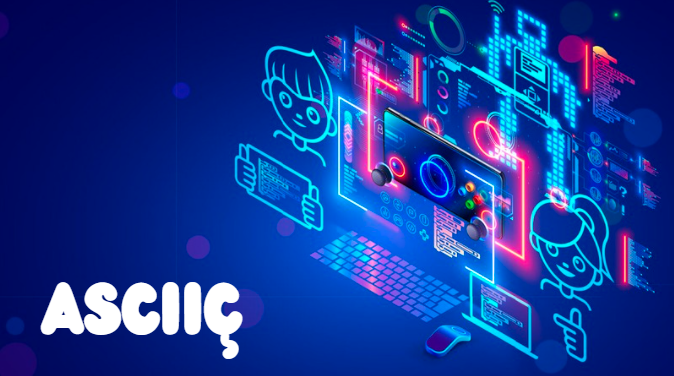The Comprehensive Guide to ASCIIÇ: Understanding Its Significance in Modern Computing
ASCII, or the American Standard Code for Information Interchange, is a fundamental character encoding system that plays a crucial role in modern computing. The term “ASCIIÇ” specifically refers to an extended version of ASCII that includes special characters like the letter ‘ç’. This guide will delve deep into the origins, usage, and importance of ASCIIÇ, providing insights that go beyond what is typically available online.
Introduction to ASCIIÇ
In the digital age, where communication and data processing are fundamental, understanding the underlying systems that make this possible is essential. ASCII (American Standard Code for Information Interchange) is one such system. ASCII was developed in the early 1960s as a way to standardize the representation of text in computers and other devices. It laid the foundation for modern character encoding systems, allowing for the exchange of information across different platforms.
However, as global communication expanded, the limitations of standard ASCII became apparent, leading to the development of extended versions like ASCIIÇ. This article will explore what ASCIIÇ is, why it matters, and how it fits into the broader context of computing.
The Origins and Development of ASCII
The Birth of ASCII
ASCII was born out of the need for a standard character encoding system that could be used universally across different types of computers. Before ASCII, there were many different encoding systems, which made data exchange between systems difficult.
In 1963, the American National Standards Institute (ANSI) introduced ASCII as a 7-bit character set containing 128 unique symbols. This set included the English alphabet (both uppercase and lowercase), digits, punctuation marks, and control characters.
Evolution of ASCII
While the original ASCII standard was sufficient for English-based text, it lacked the capacity to represent characters used in other languages. This limitation led to the development of extended ASCII, an 8-bit version that could encode up to 256 characters. The extended ASCII sets included additional symbols, accented characters, and special punctuation, making it more versatile.
The Emergence of Extended ASCII Variants
As computing technology spread globally, various countries and industries created their own versions of extended ASCII to accommodate their linguistic and technical needs. This gave rise to numerous ASCII variants, including the one we focus on in this article—ASCIIÇ. These variants often included characters specific to a particular language or region, expanding ASCII’s utility but also creating some compatibility challenges.
The Importance of ASCII in Computing
Standardization in Data Representation
ASCII’s significance lies in its ability to standardize text representation across different computing systems. Before its adoption, computers from different manufacturers often used incompatible encoding schemes, making data exchange cumbersome and error-prone. ASCII provided a common ground, ensuring that text data could be accurately interpreted regardless of the system.
Foundation for Modern Character Encodings
ASCII’s influence extends beyond its own use; it serves as the foundation for many modern character encoding systems, including UTF-8, which is now the dominant encoding on the web. Understanding ASCII is crucial for grasping how these more complex systems work.
ASCII in Networking and Protocols
ASCII also plays a vital role in networking. Many communication protocols, including HTTP, FTP, and SMTP, use ASCII to represent commands and data. This makes it possible for different systems to communicate effectively, regardless of their internal architectures.
What is ASCIIÇ?
ASCIIÇ is an extended version of the ASCII encoding system that includes the special character ‘ç’, commonly used in languages like French, Portuguese, and Catalan. The character ‘ç’, known as a cedilla, is not part of the original 7-bit ASCII character set but was included in various extended ASCII sets to accommodate non-English languages.
The Significance of the ‘Ç’ Character
The ‘ç’ character is essential in several languages, altering the pronunciation of certain letters. For instance, in French, ‘ça’ means “that,” and without the cedilla, the word would be unrecognizable. Including such characters in extended ASCII sets allowed for the accurate representation of these languages in digital formats.
ASCIIÇ in Extended ASCII Sets
In an 8-bit ASCII set, ‘ç’ is typically represented by the code 231 (0xE7 in hexadecimal). This makes it accessible in systems that support extended ASCII, allowing users to type and display this character correctly.
How ASCIIÇ Differs from Standard ASCII
Character Set Expansion
The most obvious difference between ASCIIÇ and standard ASCII is the inclusion of additional characters, particularly those needed for non-English languages. While standard ASCII is limited to 128 characters, extended versions like ASCIIÇ can represent up to 256 characters, providing much greater flexibility.
Encoding Schemes
Standard ASCII uses a 7-bit encoding scheme, which limits it to 128 characters. ASCIIÇ, as part of the extended ASCII family, uses an 8-bit scheme, effectively doubling the number of characters that can be represented. This additional bit allows for the inclusion of characters like ‘ç’, as well as many others used in various languages.
Usage in Different Environments
Standard ASCII is still widely used in environments where simplicity and backward compatibility are important. However, ASCIIÇ and other extended ASCII variants are more common in regions or applications where multilingual support is needed.
Practical Applications of ASCIIÇ
Multilingual Text Processing
ASCIIÇ is particularly useful in environments where text in multiple languages needs to be processed or displayed. For example, in a database that stores user information from around the world, the ability to accurately represent characters like ‘ç’ is crucial.
Legacy Systems and Software
Many older systems and software applications still rely on extended ASCII encoding, including ASCIIÇ. In such cases, understanding and using ASCIIÇ correctly is essential for maintaining compatibility and ensuring that text data is handled correctly.
ASCII Art and Design
ASCII art, a graphic design technique that uses characters from the ASCII set to create images, often benefits from the inclusion of extended characters like ‘ç’. These additional characters provide more options for creating detailed and expressive designs.
ASCIIÇ in Modern Programming
Programming Languages and ASCIIÇ
Most modern programming languages support extended ASCII, including ASCIIÇ. In languages like Python, Java, and C++, developers can easily work with these characters using built-in functions and libraries. This is particularly important in applications that need to handle multilingual text or interact with legacy systems.
String Manipulation and Encoding
Handling ASCIIÇ in programming often involves string manipulation and encoding techniques. Developers need to ensure that their code correctly encodes and decodes these characters, particularly when dealing with data input and output across different systems.
ASCIIÇ in Web Development
In web development, character encoding is crucial for ensuring that web pages display correctly across different browsers and devices. While UTF-8 is now the most commonly used encoding on the web, understanding ASCIIÇ remains important, especially when working with legacy systems or specific regional requirements.
Handling Character Encodings in HTML and CSS
When developing web content that includes characters like ‘ç’, it’s important to specify the correct character encoding in the HTML or CSS. This ensures that the character is displayed correctly across different platforms. In HTML, this can be done using meta tags to specify the character set, such as <meta charset="UTF-8">.
Common Challenges with ASCIIÇ
Encoding Mismatches
One of the most common challenges when working with ASCIIÇ is encoding mismatches. If a system expects standard ASCII but receives extended ASCII data, characters like ‘ç’ may not be displayed correctly, leading to data corruption or loss.
Cross-Platform Compatibility
Ensuring that text data encoded with ASCIIÇ is compatible across different platforms can be challenging, particularly in environments where different systems use different character encodings. Developers need to be aware of these potential issues and implement solutions to handle them.
Legacy System Integration
When integrating ASCIIÇ with legacy systems that may not fully support extended ASCII, developers often need to implement workarounds or conversion routines to ensure that text data is processed correctly.
How to Encode and Decode ASCIIÇ
Encoding ASCIIÇ
Encoding ASCIIÇ involves converting characters like ‘ç’ into their corresponding numerical values in the extended ASCII set. This can be done using various tools and programming languages. For example, in Python, you can use the ord() function to get the ASCII code of a character:
pythonCopy codechar = 'ç'
ascii_code = ord(char)
print(ascii_code) # Output: 231
Decoding ASCIIÇ
Decoding ASCIIÇ involves converting the numerical values back into characters. Again, this can be done using various tools and programming languages. In Python, you can use the chr() function to convert an ASCII code back into a character:
pythonCopy codeascii_code = 231
char = chr(ascii_code)
print(char) # Output: ç
Practical Examples
Consider a scenario where you need to encode and decode ASCIIÇ characters in a text processing application. By understanding the encoding and decoding process, you can ensure that text data is handled correctly across different systems.
The Future of ASCIIÇ in Computing
The Role of ASCIIÇ in a Globalized World
As the world becomes more interconnected, the need for robust character encoding systems that can handle multiple languages and scripts continues to grow. While UTF-8 has largely supplanted ASCII and its extended variants, understanding ASCIIÇ remains important, particularly in legacy systems and specific regional contexts.
Potential Developments in Character Encoding
Looking forward, we may see new developments in character encoding systems that further expand the range of characters and symbols that can be represented. However, the principles established by ASCII, including ASCIIÇ, will likely continue to influence these developments.
The Importance of Backward Compatibility
Even as new encoding systems emerge, maintaining backward compatibility with older systems that use ASCII and ASCIIÇ will remain important. This ensures that legacy data can continue to be accessed and used, preserving valuable information for the future.
FAQs About ASCIIÇ
Q1: What is ASCIIÇ?
A1: ASCIIÇ is an extended version of the ASCII encoding system that includes the special character ‘ç’, commonly used in languages like French and Portuguese. It is part of the 8-bit extended ASCII set, which allows for the representation of additional characters beyond the standard ASCII set.
Q2: How is ASCIIÇ different from standard ASCII?
A2: The primary difference between ASCIIÇ and standard ASCII is the inclusion of additional characters in ASCIIÇ, such as ‘ç’. While standard ASCII is a 7-bit encoding system with 128 characters, ASCIIÇ is part of an 8-bit extended ASCII set that can represent up to 256 characters.
Q3: Why is ASCIIÇ important in modern computing?
A3: ASCIIÇ is important because it allows for the accurate representation of characters needed in non-English languages, making it essential for multilingual text processing, legacy system integration, and certain programming and web development tasks.
Q4: How do you encode and decode ASCIIÇ characters?
A4: Encoding ASCIIÇ characters involves converting them into their corresponding numerical values in the extended ASCII set, such as using the ord() function in Python. Decoding involves converting these numerical values back into characters, using functions like chr() in Python.
Q5: What challenges are associated with using ASCIIÇ?
A5: Common challenges with ASCIIÇ include encoding mismatches, cross-platform compatibility issues, and difficulties integrating with legacy systems that may not fully support extended ASCII. Understanding these challenges is key to effectively working with ASCIIÇ.
Conclusion
ASCIIÇ represents an important evolution in the world of character encoding, bridging the gap between the original ASCII system and the needs of a globalized, multilingual world. While it may not be as widely used today as UTF-8, its role in legacy systems and specific applications remains significant. By understanding ASCIIÇ and its applications, developers, and IT professionals can ensure that they handle text data accurately and efficiently, regardless of the language or system involved.
As computing continues to evolve, the principles established by ASCII and its extended versions like ASCIIÇ will continue to influence new developments, making it essential to have a solid understanding of these foundational systems. Whether you are working with legacy systems, developing new applications, or simply seeking to understand the underpinnings of modern computing, ASCIIÇ remains a relevant and important topic.






